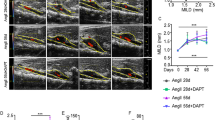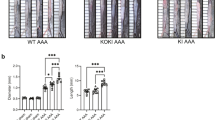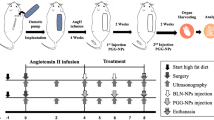Abstract
Abdominal aortic aneurysm (AAA) is one of the major vascular diseases caused by atherosclerosis. Because treatment for AAA mainly consists of surgery to prevent deaths from AAA rupture and there is a conspicuous absence of alternative therapeutic strategies, the development of minimally invasive treatment is needed. To develop a novel therapeutic approach, we examined the simultaneous inhibition of the transcription factors NFκB and ets, which regulate inflammation and matrix degradation, in a rabbit AAA model. In this study, we employed chimeric decoy oligodeoxynucleotides (ODN), containing the consensus sequences of both the NFκB- and ets-binding sites, to inhibit both the transcription factors simultaneously. Using a delivery sheet, we examined the inhibitory effect of chimeric decoy ODN on aortic dilatation. Ultrasound and angiographic analysis demonstrated that treatment with chimeric decoy ODN significantly prevented the progression of elastase-induced aortic dilatation. The inhibitory effect of chimeric decoy ODN on aortic dilatation was also confirmed by histological studies. Treatment with chimeric decoy ODN reduced the activities of matrix metalloproteinase (MMP)-2 and MMP-9 and markedly inhibited the proteolysis of elastin as compared to scrambled decoy ODN. Interestingly, treatment with chimeric decoy ODN also suppressed VCAM-1 and MCP-1 gene expression, leading to inhibition of macrophage infiltration in the adventitia and media. The present study in a rabbit model provides a novel strategy to treat AAA by the simultaneous inhibition of both NFκB and ets using chimeric decoy ODN. Further modification of chimeric decoy ODN would be useful to treat AAA as a decoy-based therapy.
This is a preview of subscription content, access via your institution
Access options
Subscribe to this journal
Receive 12 print issues and online access
$259.00 per year
only $21.58 per issue
Buy this article
- Purchase on Springer Link
- Instant access to full article PDF
Prices may be subject to local taxes which are calculated during checkout








Similar content being viewed by others
References
Cole CW . Proceedings of the workshop on the control of abdominal aortic aneurysm. Chronic Dis Can 1994; 15 (Suppl): S1–S64.
Thompson RW . Basic science of abdominal aortic aneurysms: emerging therapeutic strategies for an unresolved clinical problem. Curr Opin Cardiol 1996; 11: 504–518.
Lindholt JS, Henneberg EW, Juul S, Fasting H . Impaired results of a randomised double blinded clinical trial of propranolol versus placebo on the expansion rate of small abdominal aortic aneurysms. Int Angiol 1999; 18: 52–57.
Holmes DR, Petrinec D, Wester W, Thompson RW, Reilly JM . Indomethacin prevents elastase-induced abdominal aortic aneurysms in the rat. J Surg Res 1996; 63: 305–309.
Liao S, Miralles M, Kelley BJ, Curci JA, Borhani M, Thompson RW . Suppression of experimental abdominal aortic aneurysms in the rat by treatment with angiotensin-converting enzyme inhibitors. J Vasc Surg 2001; 33: 1057–1064.
Dobrin PB, Mrkvicka R . Failure of elastin or collagen as possible critical connective tissue alterations underlying aneurysmal dilatation. Cardiovasc Surg 1994; 2: 484–488.
Shah PK . Inflammation, metalloproteinases, and increased proteolysis: an emerging pathophysiological paradigm in aortic aneurysm. Circulation 1997; 96: 2115–2117.
Crowther M, Goodall S, Jones JL, Bell PR, Thompson MM . Localization of matrix metalloproteinase 2 within the aneurysmal and normal aortic wall. Br J Surg 2000; 87: 1391–1400.
Elmore JR, Keister BF, Franklin DP, Youkey JR, Carey DJ . Expression of matrix metalloproteinases and TIMPs in human abdominal aortic aneurysms. Ann Vasc Surg 1998; 12: 221–228.
Thompson RW, Holmes DR, Mertens RA, Liao S, Botney MD, Mecham RP et al. Production and localization of 92-kilodalton gelatinase in abdominal aortic aneurysms. An elastolytic metalloproteinase expressed by aneurysm-infiltrating macrophages. J Clin Invest 1995; 96: 318–326.
Curci JA, Liao SX, Huffman MD, Shapiro SD, Thompson RW . Expression and localization of macrophage elastase (matrix metalloproteinase-12) in abdominal aortic aneurysms. J Clin Invest 1998; 102: 1900–1910.
Tamarina NA, McMillan WD, Shively VP, Pearce WH . Expression of matrix metalloproteinases and their inhibitors in aneurysms and normal aorta. Surgery 1997; 122: 264–271.
Mao D, Lee JK, VanVickle SJ, Thompson RW . Expression of collagenase-3 (MMP-13) in human abdominal aortic aneurysms and vascular smooth muscle cells in culture. Biochem Biophys Res Commun 1999; 261: 904–910.
Nollendorfs A, Greiner TC, Nagase H, Baxter BT . The expression and localization of membrane type-1 matrix metalloproteinase in human abdominal aortic aneurysms. J Vasc Surg 2001; 34: 316–322.
Pyo R, Lee JK, Shipley JM, Curci JA, Mao D, Ziporin SJ et al. Targeted gene disruption of matrix metalloproteinase-9 (gelatinase B) suppresses development of experimental abdominal aortic aneurysms. J Clin Invest 2000; 105: 1641–1649.
Longo GM, Xiong W, Greiner TC, Zhao Y, Fiotti N, Baxter BT . Matrix metalloproteinases 2 and 9 work in concert to produce aortic aneurysms. J Clin Invest 2002; 110: 625–632.
Anidjar S, Salzmann JL, Gentric D, Lagneau P, Camilleri JP, Michel JB . Elastase-induced experimental aneurysms in rats. Circulation 1990; 82: 973–981.
Gertz SD, Kurgan A, Eisenberg D . Aneurysm of the rabbit common carotid artery induced by periarterial application of calcium chloride in vivo. J Clin Invest 1988; 81: 649–656.
Ricci MA, Strindberg G, Slaiby JM, Guibord R, Bergersen LJ, Nichols P et al. Anti-CD 18 monoclonal antibody slows experimental aortic aneurysm expansion. J Vasc Surg 1996; 23: 301–307.
Freestone T, Turner RJ, Coady A, Higman DJ, Greenhalgh RM, Powell JT . Inflammation and matrix metalloproteinases in the enlarging abdominal aortic aneurysm. Arterioscler Thromb Vasc Biol 1995; 15: 1145–1151.
Bond M, Baker AH, Newby AC . Nuclear factor kappaB activity is essential for matrix metalloproteinase-1 and -3 upregulation in rabbit dermal fibroblasts. Biochem Biophys Res Commun 1999; 264: 561–567.
Takeshita H, Yoshizaki T, Miller WE, Sato H, Furukawa M, Pagano JS et al. Matrix metalloproteinase 9 expression is induced by Epstein–Barr virus latent membrane protein 1 C-terminal activation regions 1 and 2. J Virol 1999; 73: 5548–5555.
Kim H, Koh G . Lipopolysaccharide activates matrix metalloproteinase-2 in endothelial cells through an NF-kappaB-dependent pathway. Biochem Biophys Res Commun 2000; 269: 401–405.
Miwa K, Nakashima H, Aoki M, Miyake T, Kawasaki T, Iwai M et al. Inhibition of ets, an essential transcription factor for angiogenesis, to prevent the development of abdominal aortic aneurysm in a rat model. Gene Therapy 2005; 12: 1109–1118.
Nakashima H, Aoki M, Miyake T, Kawasaki T, Iwai M, Jo N et al. Inhibition of experimental abdominal aortic aneurysm in the rat by use of decoy oligodeoxynucleotides suppressing activity of NFκB and ets transcription factors. Circulation 2004; 109: 132–138.
Yamashita A, Noma T, Nakazawa A, Saito S, Fujioka K, Zempo N et al. Enhanced expression of matrix metalloproteinase-9 in abdominal aortic aneurysms. World J Surg 2001; 25: 259–265.
Satta J, Laurila A, Paakko P, Haukipuro K, Sormunen R, Parkkila S et al. Chronic inflammation and elastin degradation in abdominal aortic aneurysm disease: an immunohistochemical and electron microscopic study. Eur J Vasc Endovasc Surg 1998; 15: 313–319.
McMillan WD, Tamarina NA, Cipollone M, Johnson DA, Parker MA, Pearce WH . Size matters: the relationship between MMP-9 expression and aortic diameter. Circulation 1997; 96: 2228–2232.
Petersen E, Gineitis A, Wagberg F, Angquist KA . Activity of matrix metalloproteinase-2 and -9 in abdominal aortic aneurysms. Relation to size and rupture. Eur J Vasc Endovasc Surg 2000; 20: 457–461.
Goodall S, Crowther M, Hemingway DM, Bell PR, Thompson MM . Ubiquitous elevation of matrix metalloproteinase-2 expression in the vasculature of patients with abdominal aneurysms. Circulation 2001; 104: 304–309.
Treharne GD, Boyle JR, Goodall S, Loftus IM, Bell PR, Thompson MM . Marimastat inhibits elastin degradation and matrix metalloproteinase 2 activity in a model of aneurysm disease. Br J Surg 1999; 86: 1053–1058.
Moore G, Liao S, Curci JA, Starcher BC, Martin RL, Hendricks RT et al. Suppression of experimental abdominal aortic aneurysms by systemic treatment with a hydroxamate-based matrix metalloproteinase inhibitor (RS 132908). J Vasc Surg 1999; 29: 522–532.
Boyle JR, McDermott E, Crowther M, Wills AD, Bell PR, Thompson MM . Doxycycline inhibits elastin degradation and reduces metalloproteinase activity in a model of aneurysmal disease. J Vasc Surg 1998; 27: 354–361.
Vandenbunder B, Wernert N, Queva C, Desbiens X, Stehelin D . Does the transcription factor c-ets1 take part in the regulation of angiogenesis and tumor invasion? Folia Biol (Praha) 1994; 40: 301–313.
Nerlov C, Rorth P, Blasi F, Johnsen M . Essential AP-1 and PEA3 binding elements in the human urokinase enhancer display cell type-specific activity. Oncogene 1991; 6: 1583–1592.
Gum R, Lengyel E, Juarez J, Chen JH, Sato H, Seiki M et al. Stimulation of 92 kDa gelatinase B promoter activity by ras is mitogen-activated protein kinase kinase 1-independent and requires multiple transcription factor binding sites including closely spaced PEA3/ets and AP-1 sequences. J Biol Chem 1996; 271: 10672–10680.
Watabe T, Yoshida K, Shindoh M, Kaya M, Fujikawa K, Sato H et al. The ets-1 and ets-2 transcription factors activate the promoters for invasion-associated urokinase and collagenase genes in response to epidermal growth factor. Int J Cancer 1998; 77: 128–137.
Campbell SE, Nasir L, Argyle DJ, Bennett D . Molecular cloning and characterization of canine metalloproteinase-9 gene promoter. Gene 2001; 273: 81–87.
Chase AJ, Bond M, Crook MF, Newby AC . Role of nuclear factor-kappa B activation in metalloproteinase-1, -3, and -9 secretion by human macrophages in vitro and rabbit foam cells produced in vivo. Arterioscler Thromb Vasc Biol 2002; 22: 765–771.
Newman KM, Jean-Claude J, Li H, Scholes JV, Ogata Y, Nagase H et al. Cellular localization of matrix metalloproteinases in the abdominal aortic aneurysm wall. J Vasc Surg 1994; 20: 814–820.
Petrinec D, Liao S, Holmes DR, Reilly JM, Parks WC, Thompson RW . Doxycycline inhibition of aneurysmal degeneration in an elastase-induced rat model of abdominal aortic aneurysm: preservation of aortic elastin associated with suppressed production of 92 kD gelatinase. J Vasc Surg 1996; 23: 336–346.
Yamasaki K, Asai T, Shimizu M, Aoki M, Hashiya N, Sakonjo H et al. Inhibition of NFκB activation using cis-element ‘decoy’ of NFκB binding site reduces neointimal formation in porcine balloon-injured coronary artery model. Gene Therapy 2003; 10: 356–364.
Busuttil RW, Rinderbriecht H, Flesher A, Carmack C . Elastase activity: the role of elastase in aortic aneurysm formation. J Surg Res 1982; 32: 214–217.
Cohen JR, Mandell C, Margolis I, Chang J, Wise L . Altered aortic protease and antiprotease activity in patients with ruptured abdominal aortic aneurysms. Surg Gynecol Obstet 1987; 164: 355–358.
Lee CH, Jeong TS, Choi YK, Hyun BH, Oh GT, Kim EH et al. Anti-atherogenic effect of citrus flavonoids, naringin and naringenin, associated with hepatic ACAT and aortic VCAM-1 and MCP-1 in high cholesterol-fed rabbits. Biochem Biophys Res Commun 2001; 284: 681–688.
Kopp CW, Hölzenbein T, Steiner S, Marculescu R, Bergmeister H, Seidinger D et al. Inhibition of restenosis by tissue factor pathway inhibitor: in vivo and in vitro evidence for suppressed monocyte chemoattraction and reduced gelatinolytic activity. Blood 2004; 103: 1653–1661.
Acknowledgements
This work was partially supported by a Grant-in-Aid from the Organization for Pharmaceutical Safety and Research, a Grant-in-Aid from The Ministry of Public Health and Welfare, a Grant-in-Aid from Japan Promotion of Science, and through Special Coordination Funds of the Ministry of Education, Culture, Sports, Science and Technology, the Japanese Government.
Author information
Authors and Affiliations
Corresponding author
Rights and permissions
About this article
Cite this article
Miyake, T., Aoki, M., Nakashima, H. et al. Prevention of abdominal aortic aneurysms by simultaneous inhibition of NFκB and ets using chimeric decoy oligonucleotides in a rabbit model. Gene Ther 13, 695–704 (2006). https://doi.org/10.1038/sj.gt.3302704
Received:
Revised:
Accepted:
Published:
Issue Date:
DOI: https://doi.org/10.1038/sj.gt.3302704
Keywords
This article is cited by
-
Estimation of Selected Minerals in Aortic Aneurysms—Impaired Ratio of Zinc to Lead May Predispose?
Biological Trace Element Research (2021)
-
Different Long-Term Outcomes of Abdominal Aortic Aneurysm and Intracranial Aneurysm Models: Hemodynamic Change may also Play an Essential Role in the Initiation and Progression of Abdominal Aortic Aneurysm in Rabbits
Cell Biochemistry and Biophysics (2014)
-
Nicotine Induces Pro-inflammatory Response in Aortic Vascular Smooth Muscle Cells Through a NFκB/Osteopontin Amplification Loop-Dependent Pathway
Inflammation (2012)
-
Risk factors for early recurrence after inguinal hernia repair
BMC Surgery (2009)
-
Regulation of MMP-2 Gene Transcription in Dermal Wounds
Journal of Investigative Dermatology (2007)



